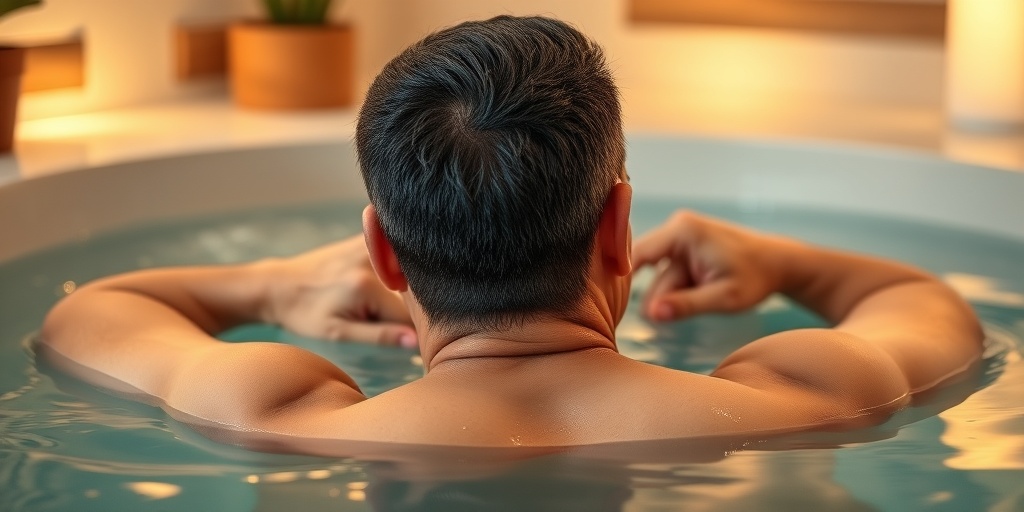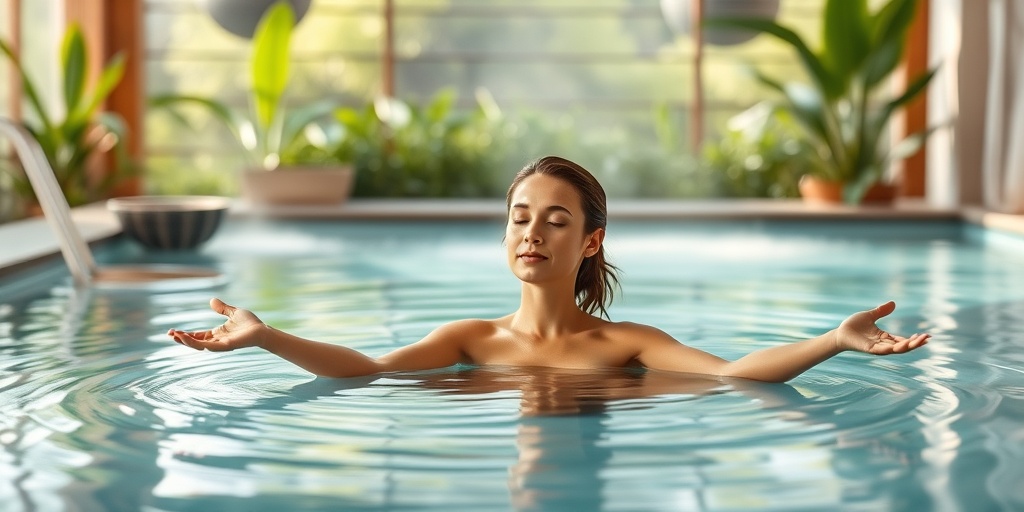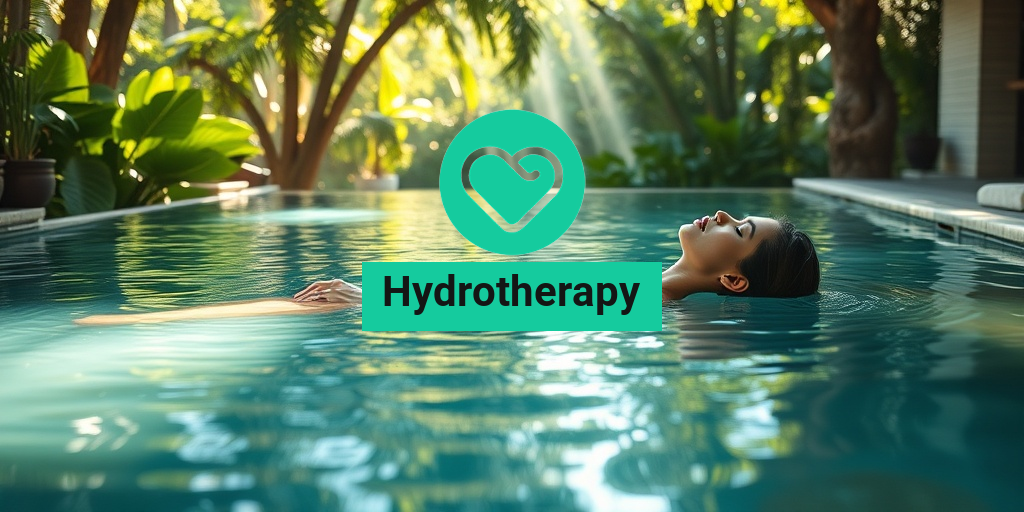What Is Hydrotherapy?
Hydrotherapy, often referred to as water therapy, is a therapeutic practice that utilizes water for pain relief and treatment. This ancient healing method has been embraced by various cultures throughout history, from the Roman baths to modern-day spas. But what exactly does hydrotherapy entail?
The Basics of Hydrotherapy
At its core, hydrotherapy involves the use of water in different forms—such as hot, cold, steam, or ice—to promote physical and mental well-being. It can be administered in various settings, including:
- Hydrotherapy spas
- Physical therapy clinics
- Home settings with simple baths or showers
Hydrotherapy can take many forms, including:
- Warm water baths: Soaking in warm water can help relax muscles and improve circulation.
- Cold water therapy: Cold water immersion can reduce inflammation and numb pain.
- Steam baths: These can help with respiratory issues and skin conditions.
- Hydro massage: Using jets of water to massage the body can relieve tension and promote relaxation.
In essence, hydrotherapy is a versatile treatment option that can be tailored to meet individual needs, making it a popular choice for many seeking relief from various ailments.
Hydrotherapy Benefits
The benefits of hydrotherapy are vast and varied, appealing to a wide range of individuals. Whether you’re an athlete recovering from an injury or someone looking to alleviate chronic pain, hydrotherapy can offer numerous advantages.
Physical Benefits
One of the most significant advantages of hydrotherapy is its ability to enhance physical health. Here are some key benefits:
- Pain Relief: Hydrotherapy can effectively reduce pain associated with conditions like arthritis, fibromyalgia, and sports injuries.
- Improved Circulation: The warmth of the water can dilate blood vessels, promoting better blood flow and oxygen delivery to tissues.
- Muscle Relaxation: The buoyancy of water reduces the strain on joints and muscles, allowing for easier movement and relaxation.
- Rehabilitation: Hydrotherapy is often used in physical therapy to help patients regain strength and mobility after surgery or injury.
Mental and Emotional Benefits
Beyond physical health, hydrotherapy also offers significant mental and emotional benefits:
- Stress Reduction: The soothing properties of water can help lower stress levels and promote relaxation.
- Improved Sleep: Regular hydrotherapy sessions can lead to better sleep quality, helping individuals feel more rested and rejuvenated.
- Enhanced Mood: The calming effects of water can help alleviate symptoms of anxiety and depression, contributing to overall emotional well-being.
Hydrotherapy for Pets
Interestingly, hydrotherapy isn’t just for humans! Many pet owners are discovering the benefits of hydrotherapy for dogs. This treatment can assist in:
- Rehabilitation after surgery
- Weight management
- Improving mobility in older dogs
Finding a hydrotherapy spa for dogs near you can provide your furry friend with the same therapeutic benefits that humans enjoy!
Conclusion
Hydrotherapy is a powerful tool for enhancing both physical and mental health. Whether you’re seeking relief from pain, looking to improve your athletic performance, or simply wanting to unwind, hydrotherapy offers a range of benefits that can cater to your needs. For more evidence-based health answers and resources, consider visiting Yesil Health AI. Embrace the healing power of water and discover how hydrotherapy can transform your well-being! 💧✨

Hydrotherapy Techniques
Hydrotherapy, often referred to as water therapy, utilizes the unique properties of water to promote healing and wellness. This versatile treatment can be applied in various ways, each designed to target specific health concerns. Here, we explore some of the most effective hydrotherapy techniques that can enhance your physical and mental well-being.
1. Aquatic Exercise
Aquatic exercise involves performing physical activities in water, which can be particularly beneficial for individuals with joint pain or mobility issues. The buoyancy of water reduces the impact on joints, allowing for a greater range of motion and less discomfort. Common aquatic exercises include:
- Water aerobics: A fun, low-impact workout that combines cardiovascular and strength training.
- Swimming: A full-body workout that improves endurance and flexibility.
- Hydrostatic pressure exercises: Utilizing the pressure of water to enhance circulation and reduce swelling.
2. Contrast Hydrotherapy
This technique involves alternating between hot and cold water treatments. The contrasting temperatures stimulate blood flow and can help reduce inflammation. It’s particularly effective for muscle recovery after intense workouts or injuries. To practice contrast hydrotherapy:
- Start with a warm shower or bath for about 3-4 minutes.
- Switch to cold water for 1-2 minutes.
- Repeat the cycle 3-4 times, ending with cold water.
3. Hydrotherapy Baths
Soaking in a hydrotherapy bath can provide immense relaxation and relief from stress. These baths often include added elements such as:
- Essential oils: Enhance relaxation and promote healing.
- Epsom salts: Help reduce muscle soreness and inflammation.
- Bubble jets: Provide a gentle massage effect, further soothing the body.
4. Hydrotherapy for Dogs
Hydrotherapy isn’t just for humans! Many pet owners are discovering the benefits of hydrotherapy for dogs. This treatment can assist in rehabilitation after surgery, improve mobility in older dogs, and even help with weight management. Techniques include:
- Underwater treadmills: Allow dogs to exercise without putting stress on their joints.
- Swimming sessions: Great for building strength and endurance.
Hydrotherapy for Pain Relief
One of the most significant benefits of hydrotherapy is its ability to provide pain relief. Whether you’re dealing with chronic pain, recovering from an injury, or managing a condition like arthritis, hydrotherapy can be a game-changer. Here’s how it works:
1. Reducing Muscle Tension
The warmth of water helps to relax tight muscles, which can alleviate pain and discomfort. When muscles are relaxed, they can function more effectively, reducing the risk of further injury. Techniques such as warm baths or hot tubs can be particularly effective for this purpose.
2. Enhancing Circulation
Water therapy promotes better blood circulation, which is crucial for healing. Improved circulation helps deliver oxygen and nutrients to damaged tissues while removing waste products. This process can significantly reduce pain and speed up recovery times.
3. Alleviating Joint Pain
For those suffering from arthritis or other joint-related issues, hydrotherapy can provide substantial relief. The buoyancy of water supports the body, reducing the weight placed on joints and allowing for easier movement. This can lead to:
- Increased flexibility: Making daily activities easier.
- Reduced stiffness: Helping to maintain mobility.
4. Stress Relief
Pain is often exacerbated by stress and anxiety. Hydrotherapy can create a calming environment, allowing individuals to relax and focus on their well-being. Techniques such as warm baths or spa treatments can help reduce stress levels, which in turn can lead to decreased pain perception.
Incorporating hydrotherapy into your wellness routine can be a powerful tool for managing pain and enhancing overall health. Whether you’re seeking relief from chronic conditions or simply looking to unwind, the benefits of water therapy are vast and varied. 🌊✨

Hydrotherapy in Rehabilitation
Hydrotherapy, often referred to as water therapy, is a powerful tool in the field of rehabilitation. It utilizes the unique properties of water to aid in recovery from injuries, surgeries, and various health conditions. The buoyancy of water reduces stress on joints and muscles, making it an ideal environment for rehabilitation exercises.
What is Hydrotherapy?
Hydrotherapy involves the use of water for therapeutic purposes. This can include treatments in pools, hot tubs, or even through specialized equipment. The benefits of hydrotherapy are numerous, including improved circulation, reduced pain, and enhanced mobility. It is particularly effective for individuals recovering from:
- Orthopedic surgeries
- Sports injuries
- Neurological conditions
- Chronic pain syndromes
How Hydrotherapy Aids Rehabilitation
The therapeutic effects of hydrotherapy stem from several key factors:
- Buoyancy: Water supports the body, allowing individuals to perform movements that may be difficult or painful on land.
- Resistance: Water provides natural resistance, which can help strengthen muscles without the risk of injury.
- Temperature: Warm water can relax muscles and improve blood flow, while cold water can reduce inflammation and numb pain.
These properties make hydrotherapy an excellent choice for rehabilitation programs. Many physical therapists incorporate hydrotherapy into their treatment plans, tailoring exercises to meet the specific needs of their patients.
Hydrotherapy Techniques in Rehabilitation
There are various techniques used in hydrotherapy for rehabilitation, including:
- Water Aerobics: Gentle exercises performed in water to improve strength and flexibility.
- Hydrostatic Pressure: The pressure exerted by water can help reduce swelling and improve circulation.
- Contrast Therapy: Alternating between hot and cold water to enhance recovery and reduce pain.
These techniques can be adapted for different rehabilitation goals, making hydrotherapy a versatile option for many patients.
Hydrotherapy for Stress Relief
In today’s fast-paced world, stress relief is more important than ever. Hydrotherapy offers a natural and effective way to unwind and rejuvenate both the body and mind. The soothing properties of water can help alleviate stress, promote relaxation, and enhance overall well-being.
The Benefits of Hydrotherapy for Stress Relief
Engaging in hydrotherapy can provide numerous benefits for stress relief, including:
- Relaxation: The warm water helps to relax tense muscles and calm the mind.
- Improved Sleep: Regular hydrotherapy sessions can lead to better sleep quality, which is crucial for managing stress.
- Enhanced Mood: The buoyancy of water can create a sense of weightlessness, promoting feelings of happiness and well-being.
Hydrotherapy Techniques for Stress Relief
There are several hydrotherapy techniques specifically designed to relieve stress:
- Soaking in a Hot Tub: Immersing yourself in warm water can help soothe muscles and promote relaxation.
- Hydro Massage: Using jets in a hot tub or spa to massage the body can relieve tension and improve circulation.
- Floatation Therapy: Floating in a saltwater tank can create a meditative state, allowing for deep relaxation.
Incorporating hydrotherapy into your routine can be a simple yet effective way to manage stress and improve your overall quality of life. Whether you’re looking for a local hydrotherapy spa or considering hydrotherapy for dogs, the benefits are clear. 🌊✨

Hydrotherapy Safety Precautions
Hydrotherapy, the therapeutic use of water, can be a fantastic way to promote relaxation, relieve pain, and enhance overall well-being. However, like any treatment, it’s essential to prioritize safety to maximize its benefits. Here are some crucial safety precautions to consider before diving into your hydrotherapy sessions.
Consult with a Healthcare Professional
Before starting any hydrotherapy regimen, it’s wise to consult with a healthcare professional, especially if you have pre-existing health conditions. Conditions such as heart disease, diabetes, or skin disorders may require special considerations. Your doctor can help determine if hydrotherapy is suitable for you and recommend specific treatments that align with your health needs.
Temperature Awareness
Water temperature plays a significant role in hydrotherapy. Generally, warm water (between 92°F and 100°F) is used for relaxation and muscle relief, while cooler water (around 65°F to 80°F) can invigorate and stimulate circulation. However, extreme temperatures can lead to burns or hypothermia. Always test the water temperature before entering and avoid prolonged exposure to very hot or cold water.
Stay Hydrated
Hydrotherapy can lead to dehydration, especially if you’re using hot water. It’s crucial to stay hydrated before, during, and after your sessions. Drink plenty of water to replenish fluids lost through sweating, and consider having a glass of water nearby while you enjoy your hydrotherapy treatment.
Supervision for Vulnerable Individuals
If you’re providing hydrotherapy for children, elderly individuals, or those with disabilities, ensure that they are supervised at all times. These groups may be more susceptible to accidents or health complications. Having someone nearby can help prevent slips, falls, or other mishaps.
Be Mindful of Duration
While hydrotherapy can be incredibly beneficial, it’s essential to be mindful of the duration of your sessions. Spending too much time in water, especially hot water, can lead to dizziness or overheating. A good rule of thumb is to limit sessions to 15-30 minutes and take breaks as needed.
Use Non-Slip Mats
To prevent slips and falls, especially in a home setting, consider using non-slip mats around your hydrotherapy area. This is particularly important in bathrooms or pools where water can create slippery surfaces. Ensuring a safe environment will help you focus on relaxation and healing.
Hydrotherapy at Home
Bringing hydrotherapy into your home can be a convenient and effective way to enhance your wellness routine. Whether you have a dedicated spa area or simply want to enjoy a relaxing bath, here are some tips for incorporating hydrotherapy into your daily life.
Creating a Hydrotherapy Space
To get started, you don’t need a fancy spa setup. You can create a hydrotherapy space in your bathroom or backyard. Here are some ideas:
- Bathtub: A standard bathtub can be transformed into a hydrotherapy haven. Fill it with warm water and consider adding Epsom salts or essential oils for added benefits.
- Hot Tub: If you have access to a hot tub, this can be an excellent way to enjoy hydrotherapy. The jets can provide a soothing massage while the warm water relaxes your muscles.
- Portable Spa: For those with limited space, a portable inflatable spa can be a great alternative. They are easy to set up and can provide a similar experience to a traditional hot tub.
Incorporating Hydrotherapy Techniques
There are various techniques you can use to enhance your hydrotherapy experience at home:
- Contrast Hydrotherapy: Alternating between hot and cold water can stimulate circulation and reduce inflammation. Try soaking in warm water for a few minutes, then switch to cold water for 30 seconds.
- Soothing Baths: Add ingredients like lavender or chamomile to your bath for a calming effect. These natural elements can enhance relaxation and improve your mood.
- Hydrotherapy Massage: Use a handheld showerhead or a bath pillow with jets to create a gentle massage effect on sore muscles.
Hydrotherapy for Dogs
Did you know that hydrotherapy isn’t just for humans? Hydrotherapy for dogs is becoming increasingly popular for rehabilitation and fitness. If you’re interested in this for your furry friend, look for local hydrotherapy spas that specialize in canine treatments. These sessions can help with recovery from surgery, arthritis, or simply to keep your pet active and healthy.
Incorporating hydrotherapy into your home routine can be a rewarding experience, offering numerous physical and mental health benefits. By following safety precautions and creating a dedicated space, you can enjoy the soothing effects of water therapy right at home! 💧✨

Frequently Asked Questions about Hydrotherapy
What is Hydrotherapy?
Hydrotherapy refers to the use of water for therapeutic purposes. It can involve various techniques, including baths, showers, and water exercises, aimed at promoting physical and mental well-being.
What are the benefits of Hydrotherapy?
- Relief from muscle and joint pain
- Improved circulation
- Enhanced relaxation and stress relief
- Support for rehabilitation after injuries
- Improved flexibility and mobility
Is Hydrotherapy safe for everyone?
While hydrotherapy is generally safe, it may not be suitable for individuals with certain medical conditions. It’s important to consult with a healthcare professional before starting any hydrotherapy treatment, especially if you have cardiovascular issues or skin conditions.
Can Hydrotherapy be used for pets?
Yes! Hydrotherapy for dogs is becoming increasingly popular. It can help with rehabilitation, weight management, and overall fitness for pets. Many facilities offer specialized programs for animals.
Where can I find Hydrotherapy services near me?
You can search online for hydrotherapy spa locations or hydrotherapy near me to find local facilities that offer these services. Many spas and wellness centers provide hydrotherapy treatments.
What types of Hydrotherapy treatments are available?
- Hydrotherapy massage – combines massage techniques with water therapy.
- Hydrotherapy baths – therapeutic baths using warm water and sometimes added minerals.
- Colonic hydrotherapy – involves cleansing the colon with water.
How does Hydrotherapy work?
Hydrotherapy works by utilizing the properties of water, such as temperature and buoyancy, to relieve pain, promote relaxation, and enhance physical recovery. The warm water can soothe muscles, while the buoyancy reduces stress on joints.
Can I perform Hydrotherapy at home?
Yes, many hydrotherapy techniques can be done at home, such as warm baths, contrast showers, or even simple foot soaks. However, for more specialized treatments, visiting a professional facility may be beneficial.
What should I expect during a Hydrotherapy session?
During a hydrotherapy session, you can expect to be guided through various water-based exercises or treatments. A trained therapist will assess your needs and tailor the session to your specific goals.
Are there any side effects of Hydrotherapy?
While hydrotherapy is generally safe, some individuals may experience mild side effects such as dizziness or skin irritation. It’s essential to communicate with your therapist about any discomfort during the session.




